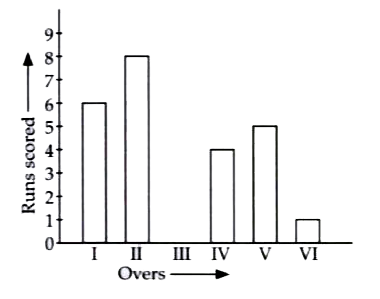The helmet of the wicket keeper is kept on the ground and the ball that the batsman strikes hits the helmet. How many penalty runs
are given to the batting team for this occurrence?
4
2
6
5
The correct Answer is:D
As per the rules: Five penalty runs are awarded to the batting team (or to the batsman in some cases) if: The ball strikes a fielder.s helmet when it is on the field but not being worn. A fielder willfully fields the ball other than with his person (for example, using a cap or other item of clothing).
Topper's Solved these Questions
Similar Questions
A foot ball is kicked off with an initial speed of 19.6m/s to have maximum range. Goal keeper standing on the goal line 67.4m away in the direction of the kick starts running opposite to the direction of kick to meet the ball at that instant. What must his speed be if he is to catch the ball before it hits the ground?
View SolutionBoxes numbered 1, 2, 3, 4 and 5 are kept in a row and they are necessarily to be filled with either a red or a blue ball such that no two adjacent boxes can be filled with blue balls. How many different arrangements are possible. given that the balls of a given colour are exactly identical in all respects?
View Solution
Knowledge Check
The formula to determine the height of the rocket above the ground at any time during the rocket’s flight is given by:
h=119t−7t2 where t =the time, in seconds, that has elapsed since the rocket was launched, and h = the height, in meters, of the rocket above the ground at time t .
The value of h was 0 when the rocket hit the ground, How many seconds after the rocket was launched did it hit the ground?A17 secB10 secC7 secD0 secThe given Bar Graph presents the runs scored (A) and strike rate (B) of a batsman in five matches. Strike Rate is the number of runs scored per 100 balls faced. The strike rate (B) is taken on record only when the batsman scores at least 30 runs in a match.

How many runs the batsman should have scored in the fifth match in as many balls he had faced in that match so that the average strike rate of the second and the fifth match becomes 120?A150B160C120D240In a one-day cricket match the captain of one of the teams scored 30 runs more than the average runs scored by the remaining six batsmen of that team who batted in the match. If the total runs scored by all the batsmen of that team were 310, how many runs did the captain score? (a) 50 (b) 60 (c) 70 (d) Cannot be determined (e) None of these
A60B70C50DCannot be determined
The benches of a gallery in a cricket stadium are 1 m wide and 1 m high. A batsman strikes the ball at a level one meter above the ground and hits a mammoth sixer. The ball starts at 35 m/s at an angle of 530 with the horizontal. The benches are perpendicular to the plane of motion and the first bench is 110 m from the batsman. On which bench will the ball hit?
View SolutionThe bar-graph given below shows the runs scored in six overs by a batsman.

How many more runs were scored in the second over than in fourth over?
View SolutionIn a one-day cricket match the captain of one of the teams scored 30 runs more than the average runs scored by the remaining six batsmen of that team who batted in the match. If the total runs scored by all the batsmen of that team were 310, how many runs did the captain score? (a) 50 (b) 60 (c) 70 (d) Cannot be determined (e) None of these
View SolutionThe given Bar Graph presents the runs scored (A) and strike rate (B) of a batsman in five matches. Strike Rate is the number of runs scored per 100 balls faced. The strike rate (B) is taken on record only when the batsman scores at least 30 runs in a match.

What is the average run scored by the batsman in the five matches?
View SolutionBaseball player A strikes the ball by hitting it in such a way that it acquires an initial velocity of 1.9 m/s parallel to the ground. Upon contact with the bat the ball is 1.2 m above the ground. Player B wishes to duplicate this strike, in so far as he also wants to give the ball a velocity parallel to the ground and have his ball travel the same horizontal distance as player A's ball does. However, player B hits the ball when it is 1.5 m above the ground. What is the magnitude of the initial velocity that player B's ball must be given?
View Solution
